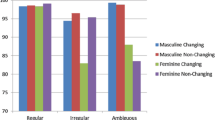Abstract
English-speaking and Italian-speaking children between the ages of 6 years 8 months and 9 years 10 months were asked to solve instructional relation problems (i.e., to complete a picture on the basis of a sentence). Sentences contained either marked or unmarked adjectival forms in one of three types of comparative construction:positive comparative (e.g., “bigger” “più grande”),negative-equative constructions as explicit negative forms (e.g., “not as big as,” “non è grande come”), orcomparative-with-less constructions e.g., “less big,” “meno grande”) as implicit negative forms. Subjects had to focus on either the grammatical subject or the grammatical object of a sentence to complete, the picture. Three findings were consistent with predictions derived by considering syntactic and pragmatic differences between explicit and implicit types of negative comparisons. First, comprehension depended on the type of comparative construction, with the poorest comprehension for the implicit comparative-with-less construction. Second, the effect of the marked adjective depended on the type of comparison. Third, in all three types of comparison, accuracy was greater when the question was focused on the grammatical subject instead of the grammatical object.
Similar content being viewed by others
References
Clark, H. H. (1969). Influence of language on solving three-term series problems.Journal of Experimental Psychology, 82(2), 205–215.
Clark, H. H. (1970). Comprehending comparatives. In G. B. Flores D'Arcais & W. J. M. Levelt (Eds.),Advances in psycholinguistics. Amsterdam: North-Holland.
Clark, H. H. (1974). Semantics and comprehension. In T. A. Sebeok (Ed.),Current trends in linguistics (Vol. 12). The Hague: Mouton.
Clark, H. H., & Card, S. K. (1969). Role of semantics in remembering comparative sentences.Journal of Experimental Psychology, 82(3), 545–553.
Clark, H. H., & Chase, W. G. (1972). On the processes of comparing sentences against pictures.Cognitive Psychology, 3, 472–517.
De Boysson-Bardies, B. (1970). Syntax and semantics in memorization of negation. In G. B. Flores D'Arcais & W. J. M. Levelt (Eds.),Advances in psycholinguistics. Amsterdam: North-Holland.
De Boysson-Bardies, B. (1977). On children's interpretation of negation.Journal of Experimental Child Psychology, 23, 117–127.
Donaldson, M. (1970). Developmental aspects of performance with negatives. In G. B. Flores D'Arcais & W. J. M. Levelt (Eds.),Advances in psycholinguistics. Amsterdam: North-Holland.
Ehri, L. C., & Ammon, P. R. (1974). Children's comprehension of comparative sentence transformations.Child Development, 45, 512–516.
Flores D'Arcais, G. B. (1966).On handling comparative sentences. Unpublished manuscript, Harvard University, Center for Cognitive Studies.
Flores D'Arcais, G. B. (1970). Linguistic structure and focus of comparison in processing of comparative sentences. In G. B. Flores D'Arcais & W. J. M. Levelt (Eds.),Advances in psycholinguistics. Amsterdam: North-Holland.
Gobbo, C., & Agnoli, F. (1983). Children's comprehension of Italian comparative form and relationship with three-term problem solution.Journal of Child Language, 10, 203–222.
Halliday, M. A. K. (1967). Notes on transitivity and theme in English: II.Journal of Language, 3, 199–244.
Higgins, E. T. (1976). Effect of presuppositions on deductive reasoning.Journal of Verbal Learning and Verbal Behavior, 15(4), 419–430.
Huttenlocher, J., & Higgins, E. T. (1971). Adjectives, comparatives and syllogisms.Psychological Review, 78(6), 487–504.
Huttenlocher, J., Higgins, E. T., Milligan, C., & Kauffman, B. (1970). The mystery of negative-equative construction.Journal of Verbal Learning and Verbal Behavior, 9, 334–341.
Huttenlocher, J. & Strauss, S. (1968). Comprehension and a statement's relation to the situation it describes.Journal of Verbal Learning and Verbal Behavior, 7, 527–530.
Huttenlocher, J., & Weiner, S. L. (1971). Comprehension of instructions in varying contexts.Cognitive Psychology, 2, 1–56.
Jones, S. (1968). Instructions, self-instructions and performance.Quarterly Journal of Experimental Psychology, 20, 74–78.
Klima, E. S. (1964). Negation in English. In J. A. Fodor & J. J. Katz (Eds.),The structure of language. Englewood Cliffs, New Jersey: Prentice-Hall.
Slobin, D. I. (1966). Grammatical transformations and sentence comprehension in childhood and adulthood.Journal of Verbal Learning and Verbal Behavior, 2, 219–227.
Wason, P. C. (1959). The processing of positive and negative information.Quarterly Journal of Experimental Psychology, 11, 92–107.
Author information
Authors and Affiliations
Rights and permissions
About this article
Cite this article
Gobbo, C., Agnoli, F. Comprehension of two types of negative comparisons in children. J Psycholinguist Res 14, 301–316 (1985). https://doi.org/10.1007/BF01068088
Accepted:
Issue Date:
DOI: https://doi.org/10.1007/BF01068088




